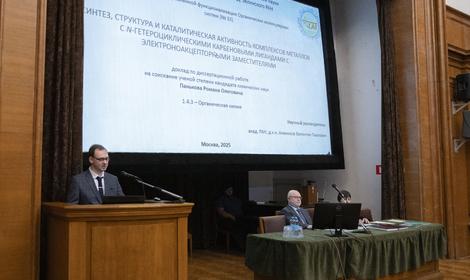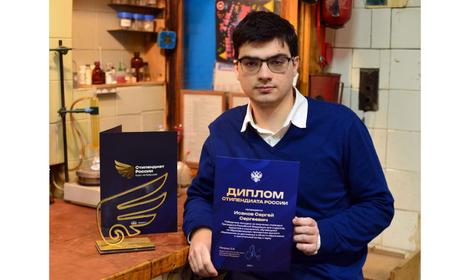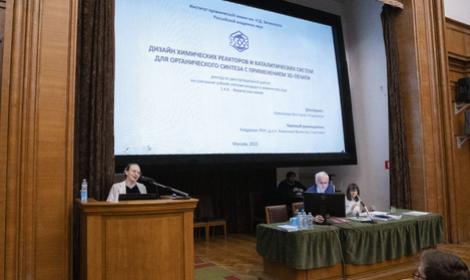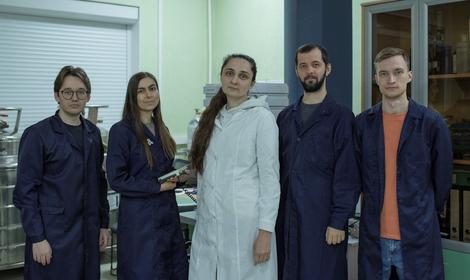Лаборатория энергонасыщенных мономеров и полимеров (№ 20)
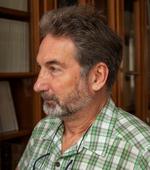
- Разработка методологии синтеза, изучение реакционной способности и структуры энергоемких органических мономеров, содержащих эксплозофорные группы (нитро, нитрамино, азидо, и др.).
- Синтез энергонасыщенных полимеров.
- Химия производных фуразана (1,2,5-оксадиазола)
✓ Being a liquid at room temperature, the crystalline form of 3,4-dinitrofurazan (DNF) has long been the subject of theoretical predictions. Its detonation performance in the solid state was calculated based on very high crystal density (1.98-2.02 g/cm3) predicted by group additivity schemes. Using zone melting technique, we were able to grow a DNF single crystal of suitable quality for X-ray diffraction study. The experimental density was found to be 1.917 g/cm3 at 100K, which corresponds to 1.85 g/cm3 at room temperature, that is significantly lower than erlier predicted. We found that the ortho-nitro groups of DNF are not equivalent and behave differently upon the crystal structure formation, which was not taken into account in the theoretical estimates carried out earlier. It has now been shown that using the ΔOED-based densification approach, this "ortho-effect" can be clarified and quantified. The observed effect is probably characteristic of all polynitro compounds, where nitro groups are brought together.
✓ The combustion behavior and thermal stability of 4,6,8-trinitro-4,5,7,8-tetrahydro-6H-furazano[3,4-f]-1,3,5-triazepine (FRDX) and 1,4,5,8-tetranitrodifurazano[3,4-c][3,4-h]tetraazadecaline (FTNAD) were investigated and compared with analogs, where the furazan ring is substituted with CH2 or C=O units. It has been shown that the furazan-fused unit reduces the thermal stability of azacyclic nitramines, probably due to the weakening of the N‑NO2 bond. The burning rates of FRDX and FTNAD are determined by the kinetics of heat release in the melt. There is the peculiar effect of the furazan unit on the burning rate: according to thermocouple measurements, the unit increases the volatility of cyclic nitramines and reduces the temperature of the burning surface, which should lead to a decrease in the burning rate, but on the other hand, it simultaneously increases the rate of heat release in the melt, and as a result, the burning rate increases rather than falls.
✓ The first examples of (perchlorylamino) heterocycles, perchlorylaminofurazans, were synthesized by the reaction of N-lithiated and N-silylated aminofurazans with FClO3 and Cl2O7. Energetic salts that are comprised of nitrogen-rich 1,2,4-triazol-based cations and the 3-nitro-4-(perchlorylamino)furazan anion, the predicted performance of which as explosives are close to or superior to that of HMX, were synthesized and characterized. Although the explosive outputs of the perchlorylaminofurazan salts are better compared with closely related nitraminofurazan salts, they are significantly more susceptible to degradation (explode!) upon impact, friction or heating.
✓ Combustion behavior, flame structure, and thermal decomposition of hybrid compounds based on tetrazine, triazole and furazan rings have been described. It has been found that the introduction of [1,2,4]triazolo[4,3-b][1,2,4,5] tetrazine core into the molecules of energetic materials allows obtaining energetic hybrid compounds with combustion rates greater than those of common explosive HMX and RDX. These hybrids have good thermal stability, which depends on the substituent at the furazan ring, and not on the triazolotetrazine core. Combustion with thermocouple-aided studies has shown that all triazolotetrazine hybrids are nonvolatile and have high burning surface temperatures which cause their condensed-phase combustion mechanism. Based on the condensed-phase combustion model, the constants of the leading combustion reactions were determined. It turned out that the burning rates of nitrogen-rich compounds of this study are controlled by the decomposition kinetics at surface temperature. It is shown that the two-stage decomposition of substances leads to the appearance of two regions in the burning rate-pressure dependences that related to each other by the instability region. The incorporation of the triazolotetrazine moiety into an energetic compound is a promising way to design new propellant components with high burning rates and attractive performance.
✓ The synthesis of a new energetic 1,2,4-triazole compound bearing nitrofurazanyl and fluorodinitromethyl units, which may find use as a component for rocket ramjet engines (RRE), is described. The target product was prepared in a four-step process applying oxidation/nitration/decarboxylation/fluorination reactions and is fully characterized. Its density and structural features were uniquely determined by X-ray analysis. It is shown that replacing HMX with the compound of this study in boron-based fuels gives an increase in energy.
✓ Although desirable from an energetic materials chemistry perspective, nitroazoles bearing oxygen-rich explosophoric units at a nitrogen atom of the ring are highly challenging target using current literature approaches. In this paper, we report the first simple two-step protocol to efficiently make unprecedented N-(2-fluoro-2,2,-dinitroethyl) derivatives of imidazole, pyrazole, triazole, and tetrazole. Michael addition of NH-azoles to 1,1-dinitroethene, generated from 1,1,1-trinitroethane, followed by fluorination provides the N-dinitrofluoroethylated nitrogen heterocycles in moderate to good overall yields. The syntheses employ azoles with electron-withdrawing groups, predominantly, nitro group, and can be extended to other structurally attractive electron-deficient NH-heterocycles.
✓ Taking into account the manifold requirements for future rocket industry breakthroughs, the scientific community is currently focusing on the design of novel higher performance, high-tech and environmentally more acceptable materials compared with conventional propellant ingredients for liquid, solid, gelled, and hybrid propellant systems. Earlier, considerable efforts were made to find environmentally friendly chlorine free alternative to ammonium perchlorate (AP) which is still the main oxidizer for solid propellants; however, success on this way is extremely rare. In this work, an novel oxygen-rich energetic material, 4,4',5,5'-tetranitro-2,2'-bis(trinitromethyl)-2H,2'H-3,3'-bipyrazole (11), was obtained by N-alkylation of 4,4',5,5'-tetranitro-2H,2'H-3,3'-bipyrazole (9) with bromoacetone and subsequent nitration. X-ray single-crystal diffraction confirmed its structure and revealed a unique high crystal density of 2.021 g cm−3 at room temperature, introducing it into the top three of the densest CHNO compounds known. This high density material has an attractive positive oxygen balance, acceptable sensitivity, enthalpy of formation (on an unit of weight) similar to CL-20, with calculated specific and effective impulses exceeding those of AP and ADN, making it a competitive replacement for AP as a green energetic oxidizer for diverse propellants.
✓ The first synthetic route to structurally unique conjugated N-hydroxy nitroenamine is reported. This method start with 1,1-diamino-2,2-dinitroethene (FOX-7) and utilize hydroxylamine for transamination reaction to generate the targeted high energetic material, the structure of which was established by X-ray crystallography.
✓ A novel and convenient one-pot synthesis of 5,10-bis(trinitromethyl)- (5) and 5,10-bis(fluorodinitromethyl)-furazano[3,4-e]di([1,2,4]triazolo)[4,3-a:3',4'-c]pyrazines (6) based on the reaction of 5,6-dichlorofurazano[3,4-b]pyrazine with 5-(trinitromethyl)- and 5-(1-fluoro-1,1-dinitromethyl)tetrazoles, correspondingly, was developed. The use of the mild protocol allows to synthesize the products in excellent yields at moderate temperature and short reaction times. For the first time, these polynitrated compounds, which may have potential use as explosive and propellant ingredients, were fully characterized. It was shown, that the burning rate of compound 5 is slightly superior to the burning rate of CL-20.
✓ An efficient and reliable synthesis of 2,4,6-tris(2-fluoro-2,2-dinitroethoxy)-1,3,5-triazin (1) has been developed. The ether 1 was fully characterized by IR and multinuclear NMR spectroscopy, and X-ray crystal structure determinations. The compound exhibits good density, excellent thermal stability, and high performance, while impact sensitivities are comparable to TNT.
✓ The multicomponent reaction of 2,4,6-trichloro-1,3,5-triazine with potassium trinitromethane and trinitroethanol was exploited for the first synthesis of the hetaryl trinitroethyl ether, 2,4-bis(2,2,2-trinitroethoxy)-6-trinitrometyl-1,3,5-triazine 13. The use of compound 13 as a scaffold for the synthesis of substituted trinitroethoxytriazine by sequential nucleophilic substitution processes is described. A number of trinitroethoxytriazines bearing a range of functional groups, including 2,4,6-tris(2,2,2-trinitroethoxy)-1,3,5-triazine 16, have been prepared. There has been no previous incorporation of the trinitroethoxy moiety to a heteroaromatic ring. All trinitroethoxytriazines were fully characterized using IR and multinuclear NMR spectroscopy, elemental analysis, and differential scanning calorimetry (DSC), and, in some cases, 16, 20 and 21, with single crystal X-ray structuring. When compared to the aliphatic trinitroethoxy compounds, the trinitroethoxytriazines show better energetic performance as calculated. The impact sensitivities and ignition points of the novel oxygen and nitrogen-rich triazines were measured. Ability of the applying trinitroethoxytriazines in solid composite propellants as well as in gas generant compositions for airbag inflators was evaluated. The straightforward preparation of these ethers highlights their as valuable new environmentally friendly and high-performing nitrogen and oxygen-rich materials.













